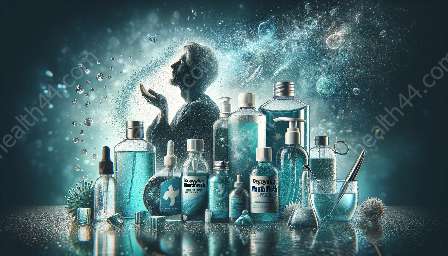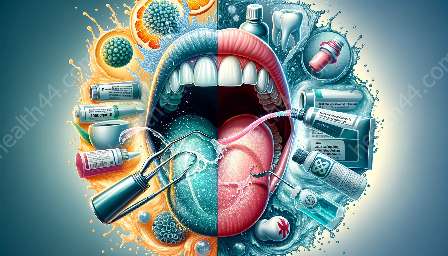When it comes to maintaining oral health, the role of mouthwash in impacting the oral microbiome is a topic of great interest. This comprehensive guide aims to delve into the complexities of how mouthwash affects the oral microbiome, while also addressing common misconceptions about mouthwash and rinses.
The Oral Microbiome: A Complex Ecosystem
The human oral cavity harbors a diverse and complex community of microorganisms, collectively known as the oral microbiome. This microbiome plays a crucial role in maintaining oral health by protecting against pathogens, aiding in digestion, and contributing to the overall balance of the oral environment.
Understanding the Impact of Mouthwash
Mouthwash has been used for decades as a part of oral hygiene routines, with the primary aim of killing bacteria and freshening breath. However, the impact of mouthwash on the oral microbiome goes beyond its superficial benefits. It is important to recognize that while mouthwash can help control harmful bacteria, it also has the potential to disrupt the delicate balance of the oral microbiome.
The Role of Antimicrobial Agents in Mouthwash
Many commercial mouthwashes contain antimicrobial agents such as chlorhexidine, cetylpyridinium chloride, and essential oils, which are designed to target and reduce the population of harmful bacteria in the oral cavity. While these agents can be effective in combatting oral pathogens, they may also inadvertently affect the beneficial microorganisms that contribute to the overall health of the oral microbiome.
Alcohol Content and Oral Microbiome
Alcohol-based mouthwashes have been a popular choice for their ability to kill bacteria and provide a refreshing sensation. However, the high alcohol content in some mouthwashes can lead to dryness of the oral mucosa and may potentially disrupt the natural balance of the oral microbiome. This underscores the need to consider the potential impact of alcohol-based mouthwashes on the oral ecosystem.
Common Misconceptions about Mouthwash and Rinses
Despite the widespread use of mouthwash, there are several misconceptions that surround its effectiveness and benefits. It is important to debunk these misconceptions to better understand the true impact of mouthwash on the oral microbiome.
Misconception 1: Mouthwash Can Substitute for Proper Oral Hygiene Practices
One common misconception is that using mouthwash alone can replace the need for proper brushing and flossing. While mouthwash can complement oral hygiene practices, it should not be relied upon as a sole method of maintaining oral health. Brushing and flossing remain essential for effective plaque removal and overall oral hygiene.
Misconception 2: All Mouthwashes Are Created Equal
Another misconception is that all mouthwashes have similar effects on the oral microbiome. In reality, different types of mouthwashes contain varying ingredients and have distinct mechanisms of action. Understanding these differences is crucial for selecting a mouthwash that aligns with your specific oral health needs.
The Future of Mouthwash and Oral Microbiome Research
As our understanding of the oral microbiome continues to evolve, researchers are exploring the potential for personalized oral care products that can target specific microbial imbalances while preserving the overall diversity and health of the oral microbiome. This personalized approach holds promise for optimizing the impact of mouthwash on oral microbiome without compromising its delicate ecosystem.
Conclusion
The impact of mouthwash on the oral microbiome is a multifaceted area of study that requires careful consideration of its benefits and potential drawbacks. By understanding the complexities of the oral microbiome and debunking common misconceptions about mouthwash, individuals can make informed choices that promote optimal oral health and hygiene.









